Schwinn was created in Chicago Illinois, USA in 1895 and eventually grew to become the dominant manufacturer of American bicycles through much of the 20th century. It is now part of the Pacific Cycle group, and has begun launching electric bicycles such as the Schwinn Monroe 250, it’s most affordable model. Three things that stood out to me when testing this bike were how lightweight, affordable, and smooth it was. Despite being priced at $1,199, this ebike comes in three sizes and features color-matched fork, grips, saddle, and stylish deep dish rims. It would be perfect for city riding because its single-speed drivetrain won’t get bumped out of alignment easily at racks, the battery is removable for charging and safe keeping in your office, and the display is compact and simple. You could lock this thing up to a bike rack and not have to worry so much about scratches and tips… except for the power cable that protrudes from the right rear axle. And, even if the bike were completely broken or stolen at some point, it’s a lot less painful to lose ~$1k than the $2k+ of most other purpose-built electric bikes. Perhaps you’re the type of person who lives up stairs and wants to store the entire bike inside? That’s going to be easy here because of the wide open triangle and straight top tube. The bike is very well balanced and even has enough room inside the triangle for a bottle cage mount, which could also work for a folding lock, mini-pump, or other standard accessory. The trade-off here is that the frame feels more rigid and positions your body in a more forward leaning sporty angle… even mounting the frame requires a flexible sporty mindset compared to a mid-step or step-thru. And, compromises were made to keep the price low. The Monroe 250 uses mechanical rim brakes vs. v-brakes or disc brakes and the motor is more efficient and smooth than zippy. Depending on your fitness level and willingness to pedal, climbing could be a challenge compared to the Monroe 350 or other competing models with more powerful motors.
Driving this bike is a very standard, highly recognized, Bafang 250 watt internally geared hub motor. This thing is about as basic and proven as you can get… and it should be reliable. It’s what many European models use (because of their more strict legal framework around pedelec bicycles, and I have also seen it frequently on older US electric bikes to save money and before mid-drives and more fancy systems came about. It is not bad, it’s actually still very relevant because in addition to saving money and being simple, it’s lightweight, relatively quiet, and compact. It blends in with the bike and does not make it so rear-heavy, the way that larger hub motors would. The motor responds quickly to pedal assist once the bike is moving a bit, because there is only one gear and the first pedal strokes can be slow and more difficult to make. Many older electric bikes used five or six magnet sensors but the Monroe 250 and 350 have opted for the high-precision 12 magnet cadence sensor. And furthermore, both brake levers have motor inhibitor switches built-in. So as soon as you activate them, the motor cuts out and you will not be fighting the power of the bike, wasting the battery or overworking your brake pads. This e-bike does not have a throttle, and this allows it to fit into the Class 1 framework of the US, which means you can ride it almost anywhere in most cities. Throttles can be nice, but they add more potential failure points and raise the price. Ultimately, aside from the power cable feeding into the right side of the motor (which is a bit exposed and vulnerable), this thing is well designed and well chosen for this bike.
Powering the motor and LED display console is an average sized 36 volt 11.6 amp hour battery pack that is mounted to the downtube. Weighing in at ~5.6 lbs, it is positioned low and center on the frame to improve stability and create room for the bottle cage bosses and provide more space along the top tube for lifting and mounting the bike on hang-style racks. Do be careful of the wire brake line, which is run along the base of the top tube, because it could get snagged or rub into the frame and scratch it over time. Many of the other wires, for the electric assist and control systems, are internally routed through the frame. This design choice makes the bike look nice and provides good protection. I love how the battery pack slides out to the right vs. mounting down from the top and appreciate the three-bolt design of the track, which provides more strength where it attaches to the frame. It’s a nice pack for being on such a cheap bike… and batteries tend to be some of the most expensive parts of electric bicycles. It would be nice if there was a USB charging port somewhere on the bike, to use for your smartphone or lights, but at least the tires have reflective sidewalls and there’s plenty of room on the handlebar for mounting your phone and a rechargeable light separately. The charging port on the battery pack is low on the right side, which puts it near the right crank arm and creates another minor point of vulnerability, just be careful… the charger produces 2 Amps, which is very average and should take 4.5 to 5 hours for a full refill.
The cockpit and control design of this electric bike are incredibly simple. Once the battery pack has been filled and mounted properly to the frame, it does lock by the way, you just hold the power button on the control pad near the left grip, and it blinks to life. There are two menus here, the left chart shows five dots that indicate 0-5 level of pedal assist. The higher you go, the zippier and faster the motor will spin but it will also draw more power, depleting your battery more quickly. The second chart is a battery level indicator showing five dots, each representing a 20% drop. The display itself is encased in black plastic and has sealed buttons built in that seem well protected from water and dust. It does leave something to be desired when you have experienced fancier ebike products, but it gets the job done. You won’t see your speed, average speed, trip time, odometer, trip meter, range estimate, or any other fancy stats… just your power level and battery level. The buttons were easy enough to reach and press, and I like how the black casing of the display blends in with the black handlebar and matches the black spokes, chainring, pedals, and even the hub motor casing. The one thing I was conflicted about was how bright the blue LED lights were. They worked fine in broad daylight, but at night, it could be distracting or even annoying… so I have used masking tape to dim this sort of light on my own electronic devices before, and I offer that as an inexpensive way to tone down the brightness if you like.
For this review, I was able to borrow a demo bike from the Schwinn team at the Electric Bike Expo in Philadelphia. It was a large size frame and I am ~5’9″ tall weighing about 135 lbs. In order to get some up-close motor shots, I mounted one of my cameras to the frame and also invited a gentleman named John to take a ride. He described the bike and motor system as smooth but noticeable and felt that it would help him to climb hills, even though it’s rated a bit lower. John is a police officer who regularly rides a traditional unpowered Trek bicycle, and his short time on the bike seemed to be fun and thought provoking. At the end of the day, this electric bicycle may cost a bit more than $1.2k because of shipping (though Amazon Prime members may not have that issue). I noticed that the price was $99 higher on Amazon, and maybe that helps to cover shipping? While researching this e-bike, I found only very limited information on the official Schwinn web page and had to rely a bit on their catalog but mostly on my own first-hand experience. I hope that all of the specs I gathered above help you, and I invite you to provide your own insights and feedback about the bike. It reminded me of the Easy Motion EasyGo Race in terms of style, price, and power. However, that product has a much lower battery capacity. Big thanks to Schwinn for partnering with me on this review, allowing me to cover several of their models back to back (even at the expo) and to John for his willingness to go on camera and share some thoughts :)
Pros:
- Available in three frame sizes, so even though this is a pretty tall high-step frame, it should be easier to approach and more comfortable to ride for a range of people
- I love that even though the bike is minimal and simple in some ways (including price), they managed to squeeze in bottle cage bosses and fender bosses, so it can be used in many different environments… it might even work with a rear rack because of the seat stay bosses, but it didn’t have dropout bosses, just a tab for adding a chain cover (which the Monroe 350 comes with stock and I found out later that the Monroe 250 also has one!)
- This is a purpose-built electric bike with internally routed cables and a nice paint job, notice how the frame, fork, grips, saddle, and rims all have red accents to tie in and the hub motor, spokes, chainring, cranks, and pedals are all black to match
- Single speed bicycles like this tend to require less maintenance, have fewer chain drops, ride quieter, and have a cleaner cockpit which is less prone to damage in a city environment
- Weighing in at just over 42 pounds, this is one of the lightest electric bicycles I have reviewed and that makes it easier to lift up stairs if you live in an apartment, it also has a removable battery pack so you can shave 5.6 lbs more just by taking that off and going in two trips
- Great pedal choice, they are large, sturdy, and provide excellent traction vs. a cheaper plastic design, Schwinn had to cut costs on some parts to keep the Monroe 250 at that $1,200 price point but I’m glad the pedals were not one of them
- I noticed that the battery pack was attached at three points to the frame vs. just two on some conversion designs, this provides more strength and is a good move considering the more sporty rigid design of the bike
- Cadence sensors are not as responsive or fluid as torque sensors or multi-sensors but at least this one provides a higher resolution 12-magnet sensor design, it worked pretty well and was easy to track-stand with because it wasn’t measuring torque
- I love that the Hang Zhou tires were designed with a reflective stripe on the sides to increase the visual footprint of the bike and keep riders safer in traffic at night
- Very impressive two-year comprehensive warranty, though I’m not sure exactly what Schwinn’s support service looks like, the Monroe 250 might be sold direct online and therefor require more shipping costs for repairs or warranty coverage vs. getting it at a local shop
- Schwinn reps communicated to me that they are entrenched in the bike world and are committed to the new ebike space, they are able to take more than a century of bike expertise and translate that into their offerings to emphasize geometry and fit, they have a US-based customer service rep team that are available to answer consumer questions or if there are issues
Cons:
- Rigid Aluminum alloy bike frames can feel stiff and uncomfortable when ridden on bumpy terrain, especially with thin tires, the Monroe 250 aims for efficiency, affordability and lightweight but you could swap in a cheap 27.2 mm seat post suspension like this to take the edge off, and the steel fork provides a bit of vibration dampening on its own
- Some of the compromises I saw on the bike were mechanical linear-pull style rim brakes vs. hydraulic rim or hydraulic disc which would actuate more easily and provide some reach adjustment, rim brakes have been working fine for many years but with the added weight and speed of ebikes, it’s a bit of a step down, I do love that they have motor inhibitors however, to provide some safety in how quickly the motor will stop when you want it to
- Deep-dish rims like the ones used here offer more strength and a slight aerodynamic edge along with some fun styling, but they require more expensive tubes with longer valve stems, it’s a minor gripe but I just wanted to be clear on the trade-offs
- The power cable leading into the hub motor is a bit exposed on the right side dropout, be careful not to snag it or allow the bike to tip over onto the right side (lean it towards the left because that side of the bike is less delicate), some ebikes have derailleur guards and I feel that this could protect the wire or that a different motor design with a more tucked-in cable like the Shengyi or Dapu motors could be useful, especially since this e-bike doesn’t have a kickstand
- There’s no chain protector or guide to keep pant legs from getting greasy or snagged, it’s a minor complaint here because there’s only one gear and the chain is less likely to fall off, consider a velcro pant retainer like these to stay clean
- The compact, efficient 250 watt hub motor isn’t going to be a great climber or feel as zippy as some competing electric bike models, but it is lightweight and fairly efficient
- The display is simple, easy to reach, and appears to be durable, but it doesn’t show your speed, how far you’ve gone, or a precise range or battery estimate like some of the fancier ebike products on the market now
- The battery charger is pretty basic, the end plug is plastic vs. metal, and the port where you insert it on the right side of the battery is fairly close to the crank arm and could get snagged or broken more easily there, so be careful
- The website for this ebike was pretty sparse in information, I’m not sure how much shipping would cost or realy where the best place to buy it is
- The blue LED’s on the display panel are VERY bright, which is great during the day but could be distracting or even bothersome at night. I might put some masking tape over the display just to dull the brightness for riding in dark conditions
Resources:
- Official Site: http://www.schwinnbikes.com/usa/bikes/electric-bikes
- More Pictures: https://photos.app.goo.gl/qn1VR8QIh1Nq1ISq2


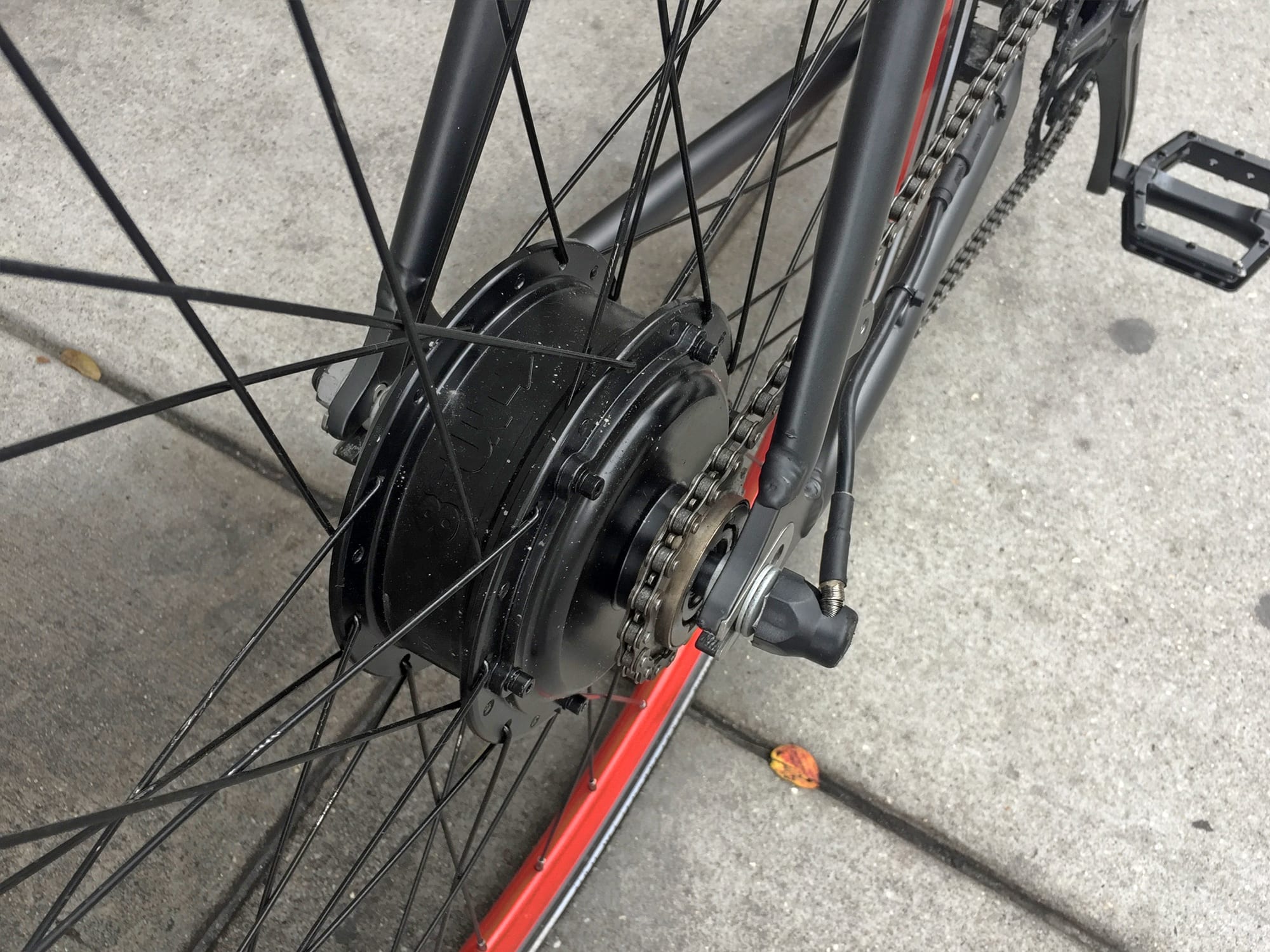
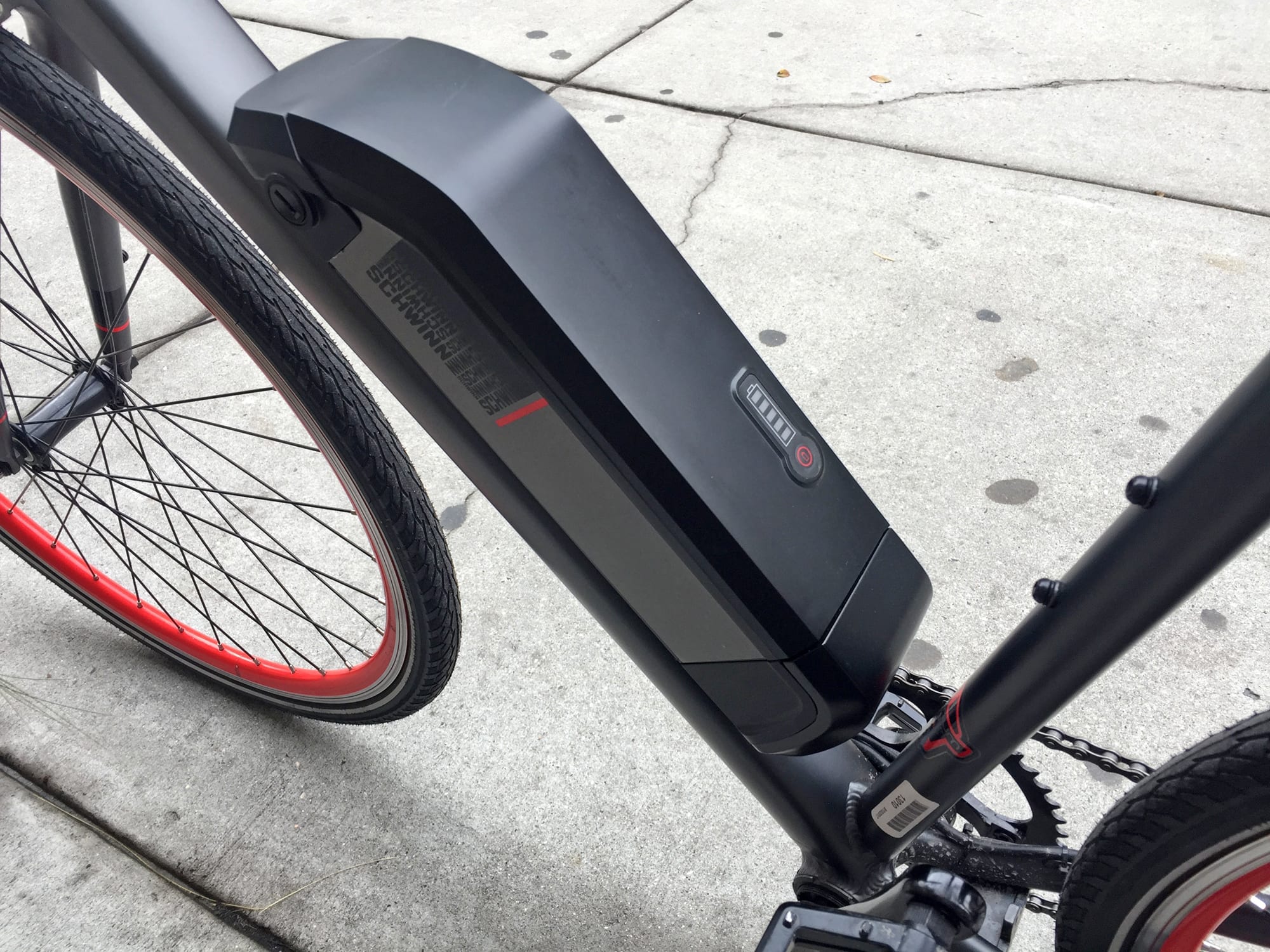
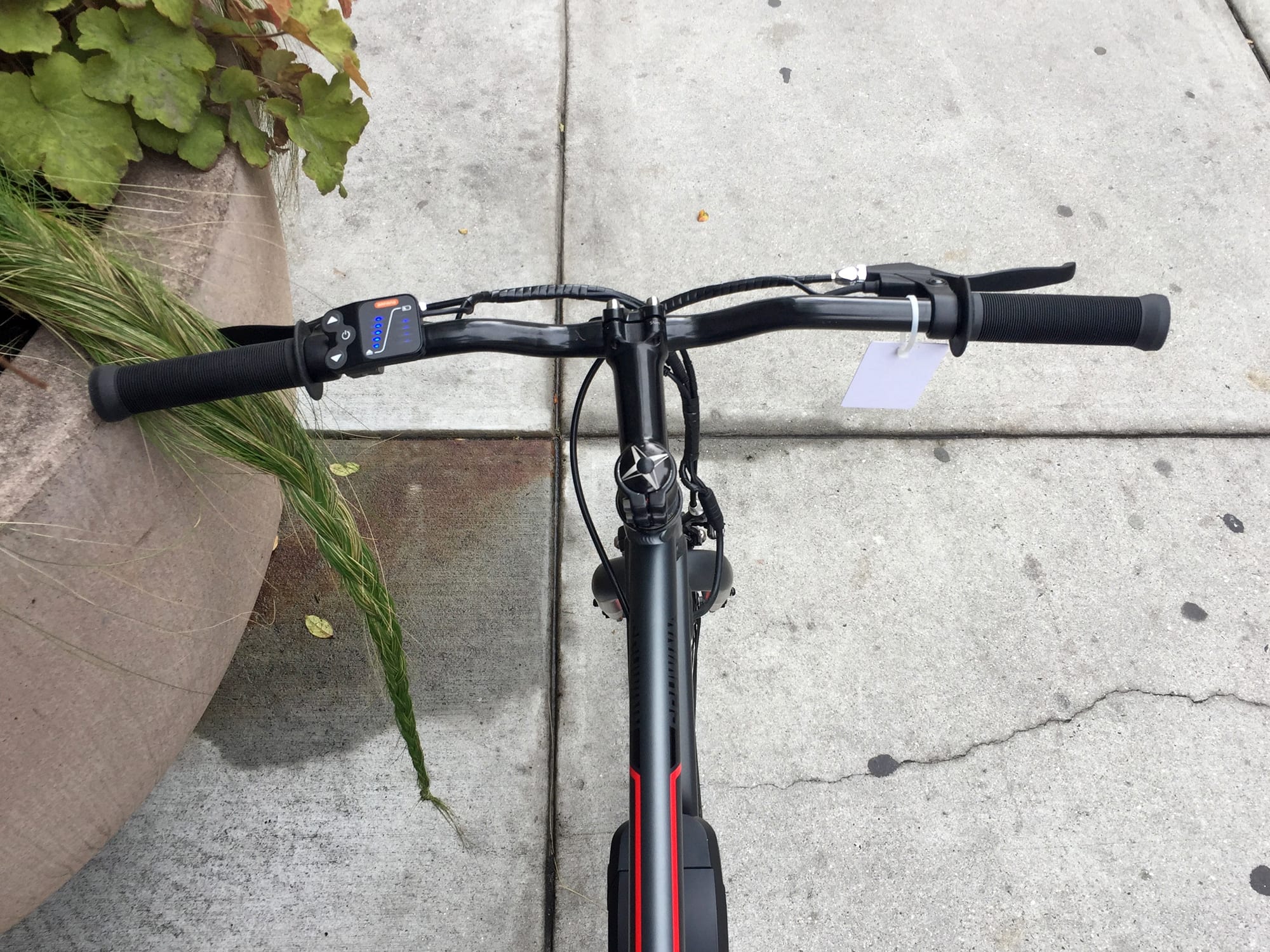

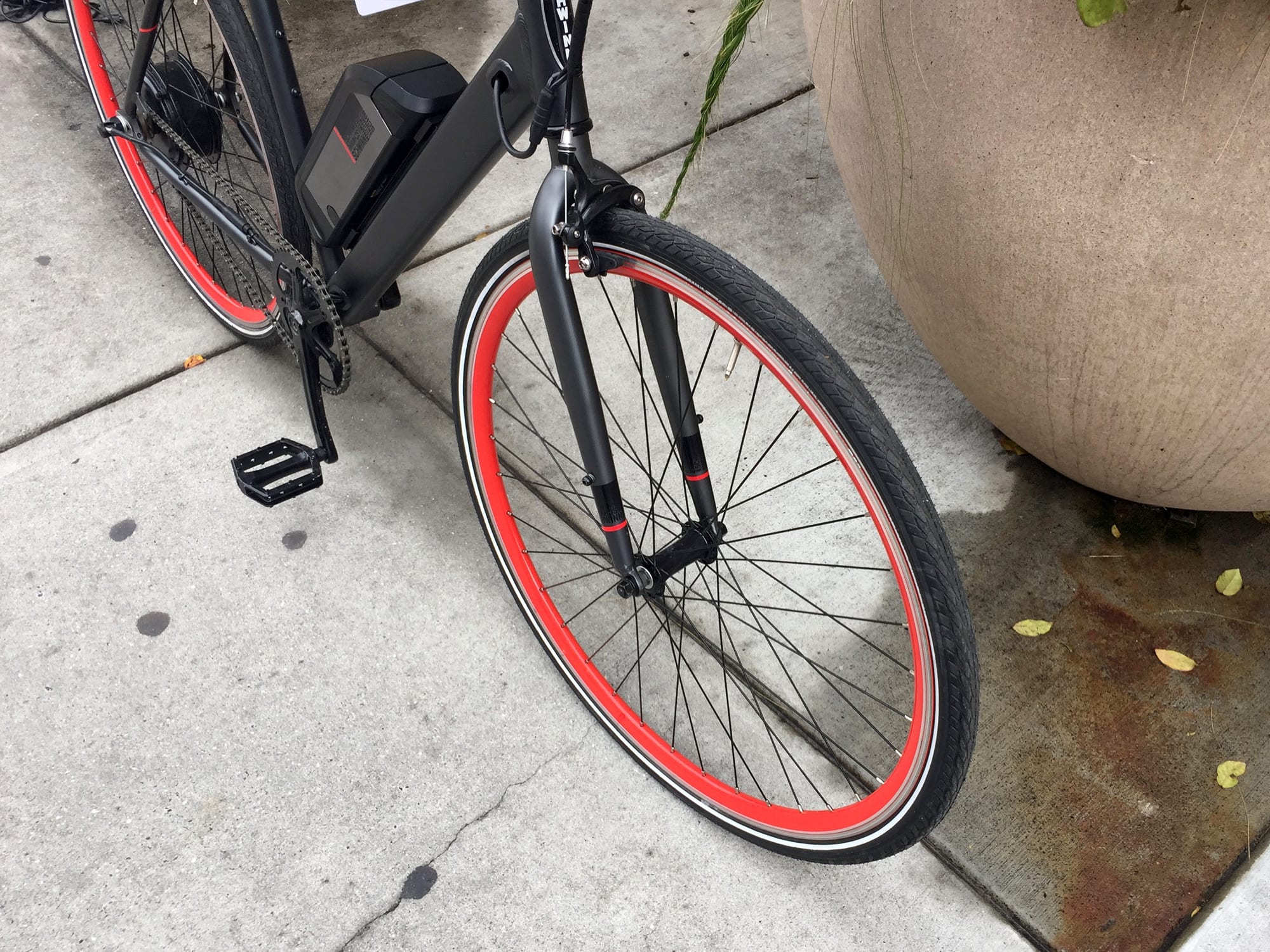
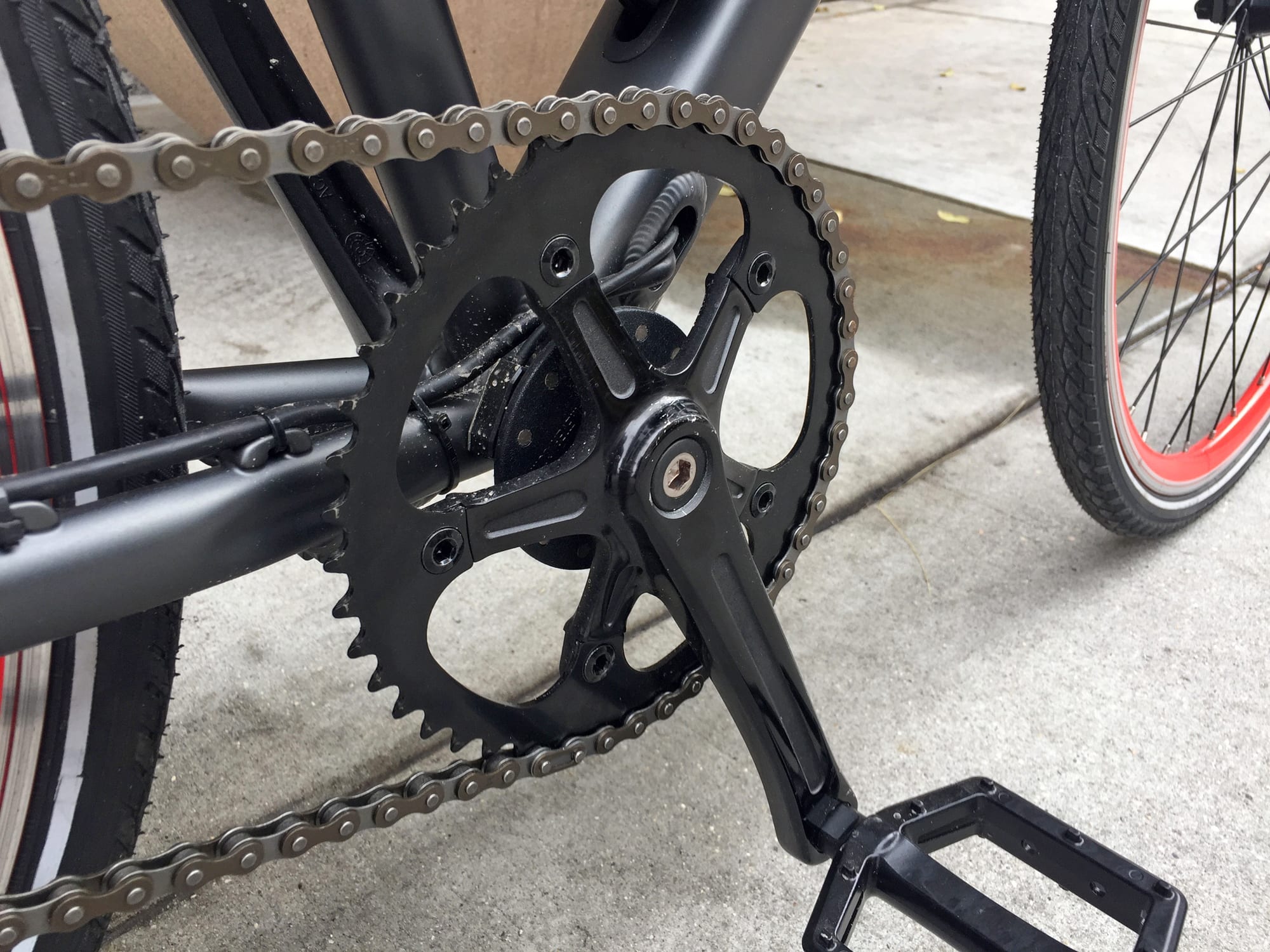
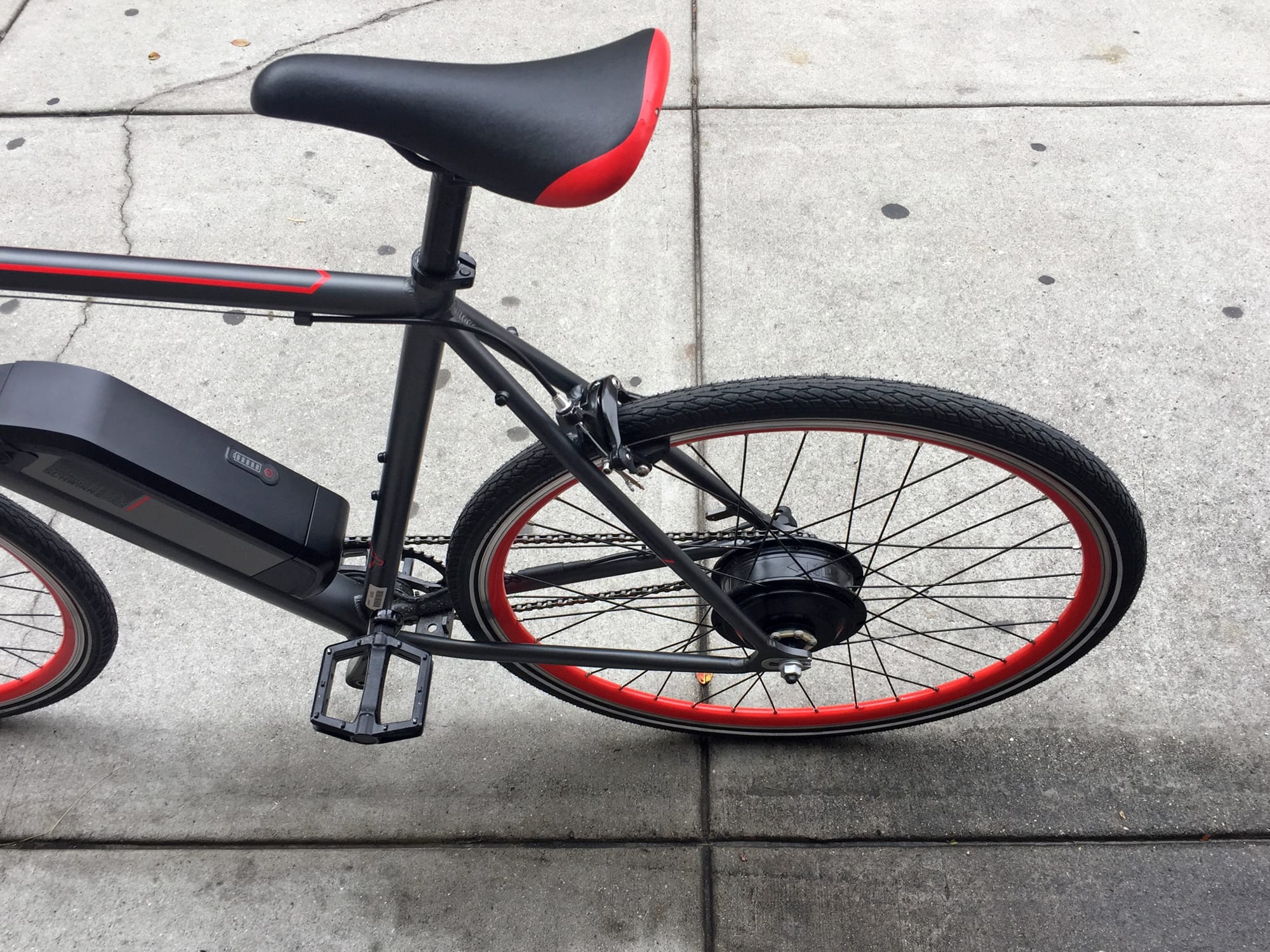


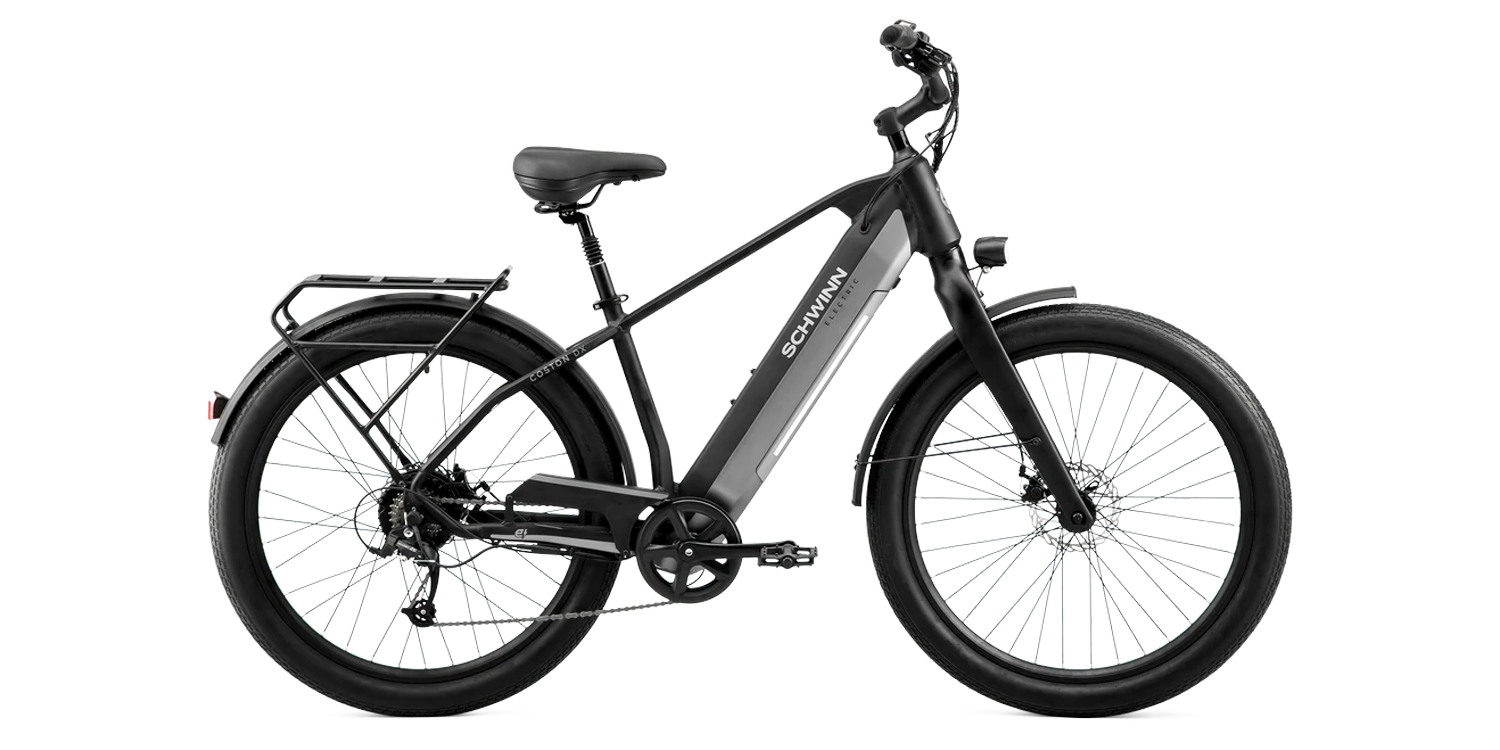
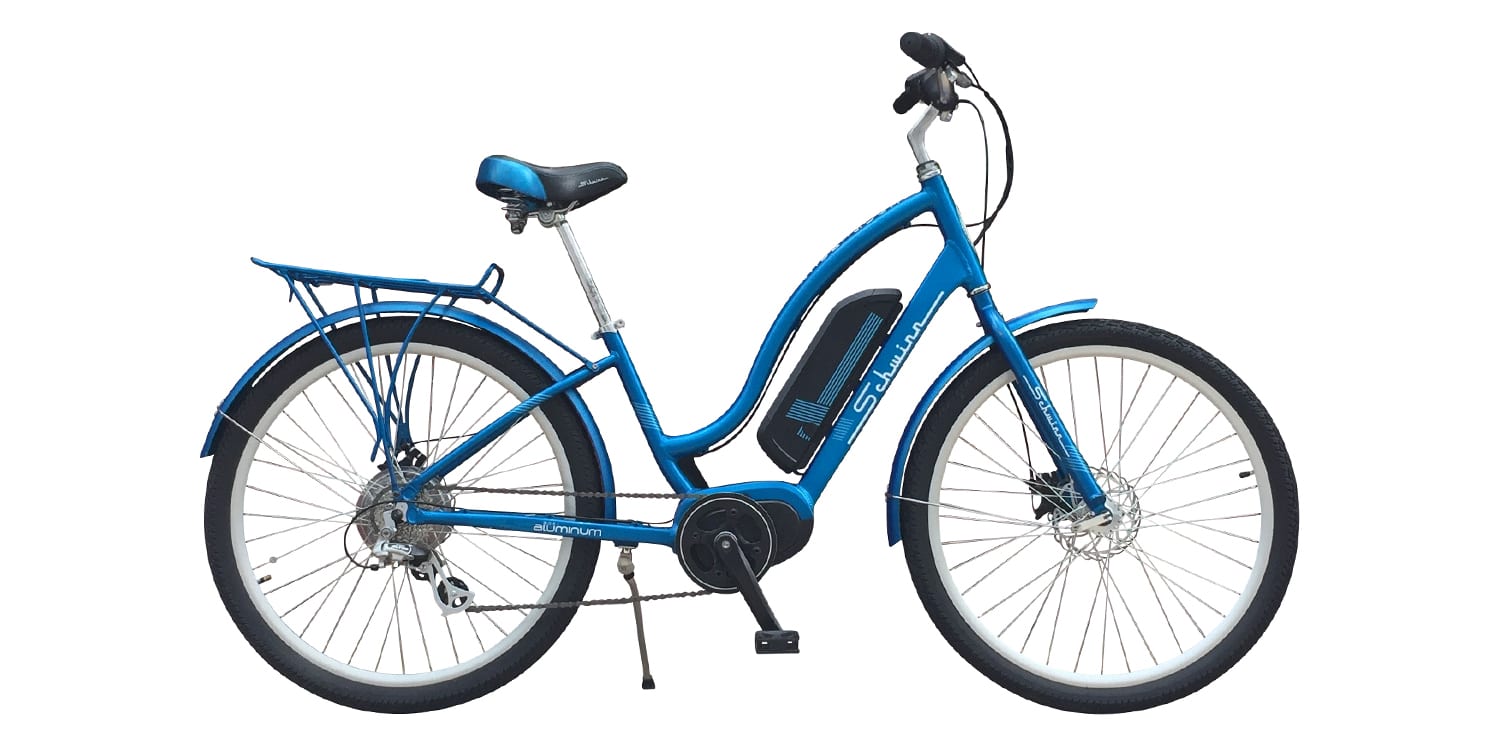


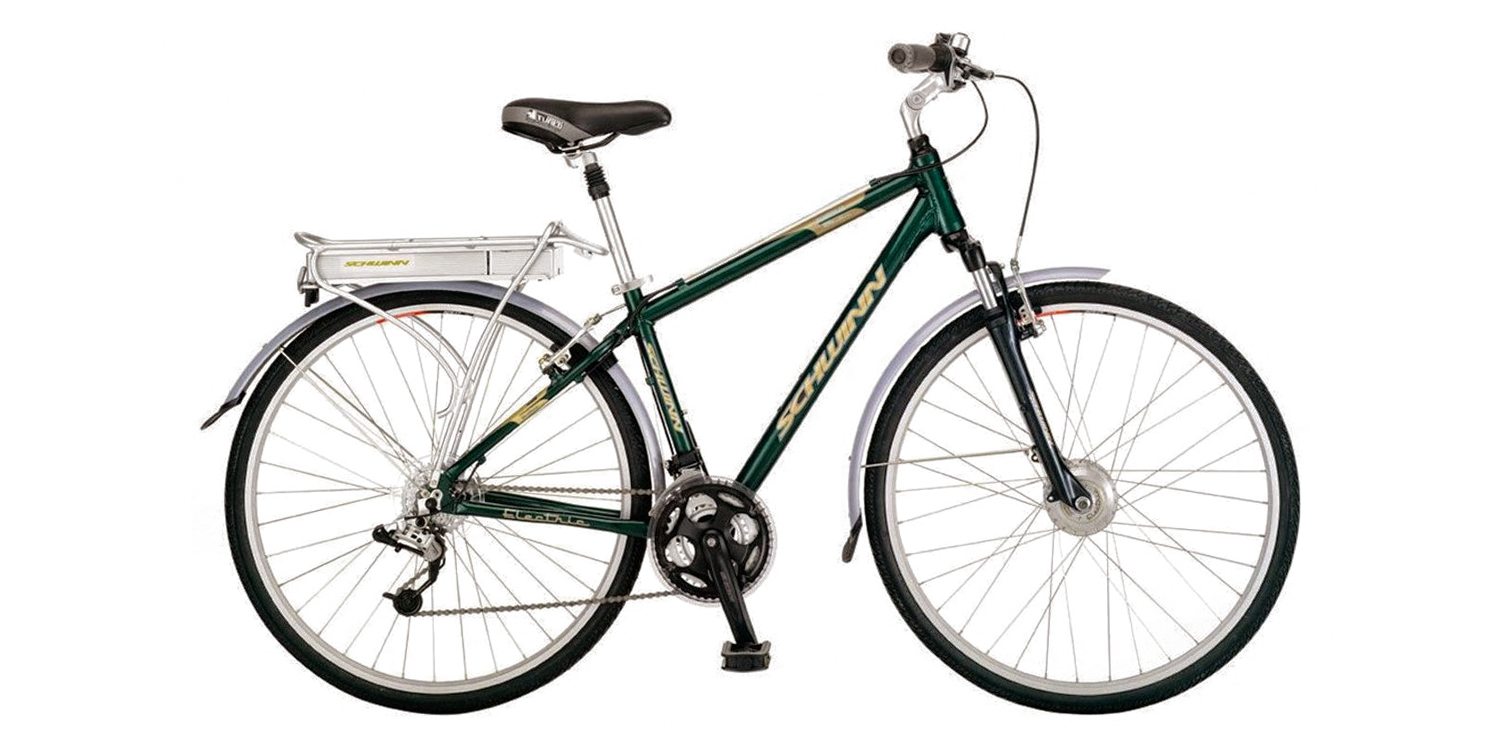
Paul Eddie says
I thought ‘Purpose Built’ meant that the bicycle incorporates the battery into the frame. From the pictures, it seems that the battery is slapped onto an existing frame. From that viewpoint, this bike is not ‘purpose-built.’ What is the feature on this bicycle that indicates that this is purpose-built?
Court Rye says
I define purpose-built as a frame that was designed specifically to integrate with an electric drive system. In this case, the battery mounts with a triple bolt pattern vs. just two, the electronic cables are internally routed through the frame, and the rear dropouts have a steel insert to provide greater strength against the motor axle (as it produces more torque and rock when starting and stopping compared to simple pedaling by the rider). The cadence sensor is also tucked inside the chainring on the right side and the cables for it are tucked in very nicely. You are correct that the battery is not fully integrated on this model, but I still think it’s a big step up from an aftermarket kit conversion with lots of wires running across the frame and a less secure or balanced battery design.
Mike says
Schwinn has definitely taken the price point the direction this market needs to go, and I’d expect their volume to be high. The Schwinn name still attracts a lot of buyers. Remember, this is now Pacific Cycle, not really ‘Schwinn’ per se’. These aren’t likely going through any LBS’s or Independent dealers, at this price point at least, and so probably only big boxes or Amazon. After sale Support will likely be none to zero, as they really have little in the way of support for regular Schwinn Bikes. So you get what you pay for, unless you can persuade them to cover something under warranty. Which MEANS, you do the parts install, and you need to do the trouble-shooting. It’ll be interesting to see how Schwinn handles things like a faulty controller, overheating, battery failure’s, diagnosing which it is, because symptoms can be the same, and you need to do hands on, and then what dealer are you taking this too. Are you going to find an ebike dealer, or if there is none nearby, will a Schwinn regular bike dealer even be capable ? Not having any gears is a downside both for the rider, and the battery, as not only will range be affected, but there will be increased cycles relating to charging. Also there will be additional strain on the motor, or you will have to put a lot of leg work into any ride, where the motor would otherwise be straining.
There is a HUGE market gap right now, for quality ebikes that are priced between $1000 and $1500, and deliver the value needed for a would be e-bike candidate rider. Certain functionality has to be there, to get these ebikes more past the early adopter, or even past the early mainstream type of buyer. Those market ‘chasm’s’ have yet to be jumped here in the US, where bikes aren’t seen as transportation or for commuting practicality as they might be in Europe or Asia.
Perhaps Schwinn can help drive to jump this next market ‘chasm’ with these sorts of price points, and some decent features delivered to justify even $1200. At this price or lower, most people would still be much better off, putting a good quality kit on their existing higher end bike that they’ve already grown to love, or maybe had love at first sight some years ago, but their bodies aged, and its more like fond memories, rather than use of the bike. The kit will almost be nearly as inconspicuous as the battery in frame, and motor in hub, sans some of the hidden wires (however not so with brands like Biria, where the tubes have large enough holes to hide nearly all the wiring from an add on kit. Great bikes by the way too, as they are German designed. ) Just my two cents.
Court Rye says
Thanks for sharing your thoughts Mike! I feel that you have a good perspective and insights on the ebike industry and agree that the $1k to $1.5k price range is a sweet and semi-served gap. Keep an eye out for the 2018 Rad Power Bikes as I feel they do an excellent job serving this segment with a high quality product and good support. You get the gears, fenders, lights, nice battery packs, fancy displays, and even some frame style/size choices but they are sold direct, just like some of these cheaper Schwinn models :)